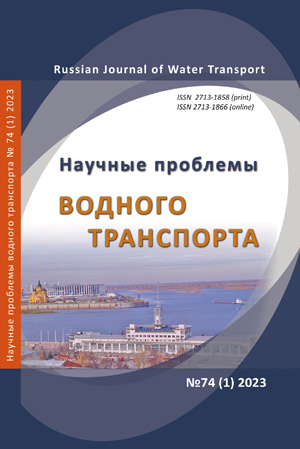On criteria of minimum thickness of plating for ships in composite materials
Abstract
The paper discusses the selection of the minimum thickness of the plating for ships made of composite materials. The reasons for restrictions are considered as the prevention of filtration and protection from contact damage. It has been established that there are two fundamental approaches: the actual thickness and the mass of the reinforcement. With the examples of ship accidents, the limitations of existing approaches to minimum thickness requirements are considered. The practice of classification societies on thickness regulation is analyzed, the approaches and the resulting thicknesses of bottom and side shells are compared, and also the ratio of inner and outer skin thicknesses. The influence of exceeding the minimum thicknesses is noted on the example of the interceptor boat project. For Russian classification societies, proposals have been formulated to improve the requirements.
References
Королев С.А. Сравнительный анализ критериев местной прочности судовых конструкций из композиционных материалов / Королев С.А., Назаров А.Г. // Научные проблемы водного транспорта, Выпуск 73, 2022.
Rules for Classification of High Speed and Light Craft. DNV, 2021.
Rules for Construction and Classification of Sea-Going High Speed Craft. China Classification Society. Beijing, 2015.
Rules and Regulations for the Construction and Classification of High Speed and Light Craft. Indian Register of Shipping, 2021.
ISO-12215 - 5:2019 Small craft - Hull construction and scantlings - Part 5 design pressures, design stresses, scantling determination. International Standards Organization.
Rules for Building and Classing High Speed Craft, ABS, 2022.
Rules and Regulations for the Classification of Special Service Craft. Lloyd’s Register, 2020.
Российский Речной Регистр. Правила (в 5-и томах). Правила классификации и постройки судов (ПКПС). – М.: Российский Речной Регистр, 2019, 1506 с.
Правила классификации и постройки морских судов. Часть XVI. Конструкция и прочность судов из полимерных композиционных материалов. Российский морской регистр судоходства, 2022.
Rules and Guidance notes. Hull in Composite Materials and Plywood, Material Approval, Design Principles, Construction and Survey, BV, 2018.
Rules for Classification and Construction of High Speed Craft. Germanischer Lloyd, 2012.
Kamath P. Design and Construction of SM16 Fast Interceptor Craft: Case Study / Kamath P., Nazarov A. // WARSHIP 2013: Minor Warships, June 2013, Bath, UK, p.131-139. https://doi.org/10.3940/rina.ws.2013.04
Copyright (c) 2023 Russian Journal of Water Transport

This work is licensed under a Creative Commons Attribution 4.0 International License.













